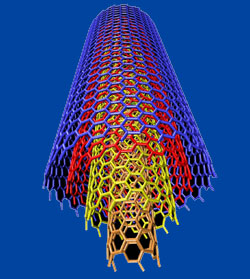While biomedicine, electronics and other fields of research are steadily moving towards sub-nanometer dimensions, the preparation of the building blocks for producing such materials is problematic

Recently, a research team from the Scripps Research Institute revealed an innovative approach to solving the problem that allows obtaining a material with new properties, which will remind many of us of flexible rubber. The material is produced with the help of natural proteins that are used as templates for the preparation of uniform structures in nanometer dimensions in a self-assembly process. The material, an organic polymer that was described in the electronic edition of the American journal "Proceedings of the National Academy of Sciences" could be applied in the future in various fields, starting with disease diagnosis and ending with microelectronics.
Using the tricks of nature
Nature is replete with examples of compounds, such as DNA, that are obtained in uniform patterns on a nanometer scale while self-assembling, but until now researchers have only been able to mimic these processes to a limited extent. The new study, however, describes one synthetic method that was able to effectively mimic the templating strategy, common in nature, to create nanoscale structures in the lab. In order to create the new material, the Scripps research team, led by the president of the research institute himself, Richard Lerner and Professor Tobin Dickerson, started with a natural nanometer product - a bacterial virus or phage. A nanometer is a billionth of a meter, or the width of a small cluster of average number of atoms. The particular product that the researchers worked on is a phage called M13. If you increase it considerably, the product is equivalent, relatively of course, to an average pencil where the tip and the eraser at the ends represent the active sites of the phage that affect the bacteria. Other proteins that are biologically inactive and parallel to the wooden shell of the pencil provide the structural shell of the phage. While working with the phage extensively in other applications, the team decided to explore the possibilities of using these structural proteins as possible manufacturing templates for the preparation of nanostructures. To this end, the team chemically changed the protein shell so that they could be attracted and bind to the components required to produce polyacrylamide strips, a common polymer for preparing laboratory gels. The resulting polymer/phage combination, which spontaneously wound into a helix like DNA and RNA compounds, creates a comb-like structure in which the polymers represent the teeth of the comb. These teeth join together and form a flexible, rubber-like solid.
Surprising flexibility
As soon as the new material, known as a protein/polymer bio-combination was obtained, the research group was amazed to find that it was almost impossible to hatch an individual sample from it. It was indeed possible to cut a piece of it, but when the researchers tried to press or compress the material as much as possible, it "jumped" back to its original shape, because the stable phage proteins function as a cement-like glue for structural strength. A closer examination was able to distinguish other important features. The "combs" do not grow completely uniformly - some of them grow more "teeth" than the others before they connect and tie together. However, in order for the separate combs to bond together chemically, they must come close enough to each other, a fact that leads to the uniformity of the spaces between the teeth. These gaps were measured and found to be 4 nanometers wide and over XNUMX micrometer (millionth of a meter) long. This uniformity is in complete contradiction with the results of other experiments which showed that by simply mixing the phages with the polymers, without the template process, a completely disordered substance is obtained at its molecular level. It is interesting that after the production of the material, the group discovered that a British researcher made theoretical calculations regarding the question of how flexible coils - such as the phages - would join together into the spatial arrangement with the lowest energy. "It was extremely satisfying to find out that the mathematicians accurately predicted the arrangement we got in the lab," says Dickerson.
Start using the material
Although the initial work was primarily aimed at proving the feasibility of using phages as production templates, the researchers already have a number of potential applications. Large quantities of the phages can be produced easily and cheaply and the polymer components are all commercial - so the new material can be easily prepared in any laboratory. These characteristics will allow economic applications in the near future. "Basically, substances created by bacteriophages are renewable resources," says the researcher.
The defined channels created by the gaps in the new material can be built in a controlled manner to obtain precise pathways for the transfer of electrons for application in the field of microelectronics, for example. Or it is possible to use new materials with predefined intervals that will be used as filters for compounds of a certain size, for example - measuring the presence and quantity of proteins that indicate the existence of a certain disease in a blood sample. More complex applications can also include changing the active biological sites of the phages for selective affinity to certain compounds, while trapping them within the gaps or vice versa - preventing the entry of harmful compounds.
"These building blocks can be compared to Lego game blocks," Dickerson says of the varied possibilities for use. "You can literally think of them in engineering terms using macroscopic equivalents like baskets or lids or perforations." In order to expand the list of possibilities for use, the group has already begun to examine additional materials that could be obtained in the basic construction process of the phages.

One response
Very nice.
And here we are advancing safely into the age of nanotechnology.